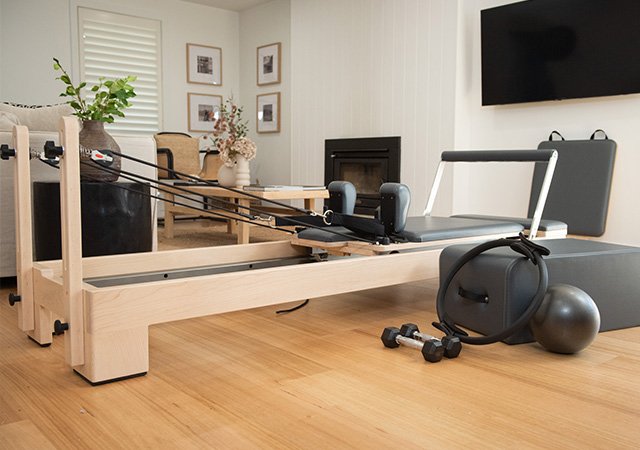
Introduce
In recent years, Pilates has gradually become a popular fitness sport around the world, attracting a large number of followers with its low-impact, comprehensive training method. However, Pilates is not limited to ground exercises. There is also a more specialized equipment-assisted version – the Pilates Reformer. This article will explore the differences between Pilates and Reformer Pilates, analyze the potential disadvantages of Reformer Pilates, explore the speed at which its effects take effect, explain why some people fail to lose weight after exercising on the Pilates Reformer, and the physical changes after one month of Pilates. In addition, it will discuss who is not suitable for practicing Pilates and explain the 80/20 principle in Pilates.
The difference between Pilates and Pilates Reformer
Pilates was originally invented by Joseph Pilates in the early 20th century as a whole-body exercise method that combines yoga, dance and strength training. Traditional Pilates is usually performed on a mat, mainly through body weight, breathing control and precise posture to achieve body coordination and strength improvement.
However, the Pilates Reformer is a machine with a sliding platform, spring resistance and adjustable accessories, designed to provide more challenging exercises. The design of the Pilates Reformer allows practitioners to train in a variety of postures, increasing the challenge to various parts of the body, especially the training of the core muscles. In addition, the Pilates Reformer can also assist in rehabilitation training and help injured athletes or patients recover better.
In terms of effect, the Pilates Reformer can exercise muscles more accurately due to its variable resistance system, especially for trainers who need to strengthen body control, balance and flexibility. Traditional Pilates is more suitable for those who are new to Pilates or prefer free practice.
Disadvantages of Pilates Benches
Although Pilates Benches offer many advantages, there are some potential disadvantages to be aware of.
- First, Pilates Benches have high equipment costs and are usually only found in dedicated Pilates studios or gyms. This makes it more expensive for people who want to practice Pilates Benches.
- Second, Pilates Benches have a steep learning curve. For beginners, training on a Pilates Bench may seem complicated and difficult to master. This not only increases the risk of injury, but may also make people feel frustrated and give up training.
- Third, Pilates Benches rely on the use of equipment, which limits the venue and time of training. If you can’t go to a Pilates studio regularly for training, it may be difficult for practitioners to maintain a consistent exercise rhythm.
How quickly the effects of Pilates take effect
The effects of Pilates vary from person to person and are usually closely related to the practitioner’s physical condition, training frequency, and training intensity. Generally speaking, if you do Pilates training 2-3 times a week, you can usually feel changes in your body within 4-6 weeks. This includes increased core strength, improved posture, and increased flexibility.
However, it should be noted that Pilates is not a quick-acting training method. It emphasizes progressive body control and muscle development, so long-term persistence is required to see significant results. For those who want to achieve rapid weight loss or body shaping through Pilates, they may need to combine other forms of aerobic exercise or diet control to achieve the desired effect.
Why I can't lose weight on the Pilates Reformer
Many people consider the Pilates Reformer as a way to lose weight, but in fact, the Pilates Reformer is more of a way of strength training and body adjustment rather than high-intensity aerobic exercise. Therefore, it may not be possible to significantly reduce weight by exercising on the Pilates Reformer alone.
The key to weight loss is the balance between calorie intake and calorie consumption. Although training on the Pilates Reformer can increase muscle mass and increase basal metabolic rate, it may still be difficult to lose weight if the calories consumed in the daily diet exceed the amount consumed. In addition, the Pilates Reformer focuses more on muscle firmness and body line shaping rather than simply weight loss.
If the goal is to lose weight, you can consider combining the Pilates Reformer with other forms of aerobic exercise (such as running, swimming, cycling), and pay attention to a balanced and healthy diet, so as to achieve the effect of weight loss overall.
Effects of One Month of Pilates
After one month of Pilates practice, the body will usually show significant changes. Although this period may not be enough to achieve a significant weight loss, the improvement in other aspects will be very obvious.
Core strength improvement
Pilates core exercises can significantly improve the strength of the abdominal, back and pelvic areas. This helps improve body posture, relieve back pain, and improve overall body stability.
Improved flexibility
Pilates emphasizes stretching and extension of the body, so one month of practice will make the body more flexible and the range of motion of the joints will be expanded.
Posture improvement
Because Pilates focuses on body alignment and posture control, one month of practice can help correct poor posture, especially physical discomfort caused by long periods of sitting or standing incorrectly.
Improved mental state
Pilates can effectively reduce stress, improve attention and concentration, and make the mental state more stable and peaceful through breathing control and body awareness training.
Who is not suitable for Pilates?
Although Pilates is a low-impact exercise suitable for most people, it is not suitable for everyone.
Patients with severe osteoporosis
Some movements in Pilates may put pressure on bones, which may increase the risk of fractures for patients with osteoporosis, especially those with severe osteoporosis.
Patients with severe spinal diseases
For example, patients with spondylolisthesis or herniated discs are not recommended to do Pilates training without the permission of a doctor to avoid aggravating their condition.
Pregnant women in the third trimester
Although Pilates during pregnancy can help maintain good health, pregnant women in the third trimester should avoid some movements that put more pressure on the abdomen and train under the guidance of professional coaches.
Patients with severe heart disease
Before doing any form of exercise, patients with heart disease should consult a doctor and ensure safety during exercise.
The 80/20 principle in Pilates
The 80/20 principle in Pilates means that 80% of the time in training should be focused on basic movements and breathing control, and the remaining 20% should be used to challenge more difficult movements or increase the intensity of training. This principle emphasizes the gradual and basic nature of Pilates training.
For beginners, the 80/20 principle can help them gradually increase the difficulty of training while laying a solid foundation, avoiding injuries caused by trying difficult movements too early. For experienced practitioners, the 80/20 principle can help them maintain basic training while constantly improving their own challenges and making greater progress.
In Conclusion
Although Pilates and Pilates Reformer have different training methods, they can both bring significant physical and psychological benefits to practitioners. However, it is important to choose a training method and rhythm that suits you, especially when considering your personal physical condition and goals. Through a scientific and reasonable practice plan and persistent efforts, everyone can find the balance and strength that suits them in the Pilates journey.





